
Hiking the Sleeping Giant Provincial Park is a practice in solitude. There are no cell phone signals here, just the lapping of waves and sunshine. (Kevin Kaiser | Travel Beat Magazine)
Back in the day, families packed up station wagons full of kids and headed out on the great American road trip around Lake Superior, the biggest, deepest Great Lake.
While the evidence of this 1940s to 1960s travel boom continues to exist today on the Lake Superior Circle Tour—not that much unlike the Historic Route 66—there is still plenty to see and do. The landscape itself is quite beautiful with soaring cliffs over a cold, blue lake and towering pines that offer shelter to wildlife such as moose and black bears.
Waterfalls and lighthouses
Across the Mackinac Bridge and along Michigan’s upper peninsula we go! We’re officially trolls, you know, as the Yoopers (long for U.P.ers) call us because we reside below the bridge.
You’ll see signs for pasties—essentially meat and potato pies the miners used to take as their lunches—and signs for waterfalls and hikes. Among our first stops was Whitefish Point Light Station near Paradise, Michigan. Whitefish Point is home to a lighthouse, the Great Lakes Shipwreck Museum, a gift shop, trails, and a Coast Guard station long abandoned in favor of a bed and breakfast (when’s the last time you stayed overnight at a lighthouse?)
The museum is fantastic and includes admission to other buildings on the site. The self-guided tour gives you a feel for what it would have been like to live (or grow up) at the secluded Coast Guard station, and the dangers of Lake Superior to those would floated their fortunes on its tumultuous waters.
Definitely bring a box or bags with you, too, because beautiful Lake Superior agate washes up along the nearby shores. It glitters rose, green, yellow, white and blue as the waves crash along the sand dunes. It’s free for the taking, so save plenty of time for finding rocky treasures that have been smoothed for years along the lake’s bottom.
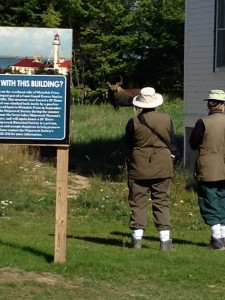
A moose made an appearance behind the Whitefish Point Light Station. (Cheryl Welch | Travel Beat Magazine)
Keep an eye out for moose and other wildlife. We spotted a big bull moose right behind the bed and breakfast at the lighthouse.
Just beyond Whitefish point, on your way along M-123 to Marquette, Michigan, you’ll find Tahquamenon Falls State Park. This is definitely worth a stop. The tea-colored water makes for waterfalls easily accessible from parking lots, and there are nice restroom and concessions available here, too. Once you make it to Marquette, definitely check out more waterfalls there. Although they’re more of a hike, they’re worth it.
Keep on heading west and stop at Pictured Rocks National Lakeshore to gaze upon the towering sandstone cliffs or to hike or kayak along their base. Not far past this stop is the Lake of the Clouds in Porcupine Mountains. Also a spot worth exploring.
Adventure into mining history
For those less excited about hiking and more excited about adventuring or history, a stop at the Adventure Mining Company in Greenland, Michigan, to see how copper mining struck it big in upper Michigan many, many years ago. This mine is a little more rustic than you’ll find elsewhere, and that makes it a whole lot of authentic fun.
Take a Swiss military offroad vehicle to the entrance of the mine, fit your lighted helmet on, and take off for a guided tour that involves a bit of scrambling and a whole lot of fun. Those who are more adventurous (and less afraid of heights) can even go rappelling in the mine to lower levels.
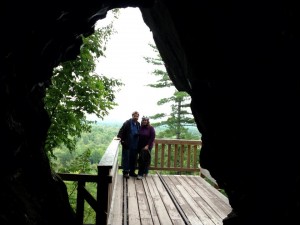
At the Adventure copper mine, there’s a platform that extends above the canopy of the forest. This is where they used to load up the copper chips that miners removed. (Cheryl Welch | Travel Beat Magazine)
If you’d prefer an easier-access mine, you’ll have to detour south a bit to Vulcan, Michigan, to the Iron Mountain Iron Mine, which you can’t miss with the giant Big John sign out front.
Here, they take tours into an iron mine via small passenger tram well into the mine, then take a short 1/4-mile hike back to see more of the mining operation. This tour is great for elderly or small children and you get a helmet and rain jacket to wear, too.
We promise that you will be singing, “John, Big Bad John…” as you leave.
Wisconsin’s Apostle Islands
As you continue along the southern shore of Lake Superior, make a stop in Bayfield, Wisconsin, one of our favorite stays along the way.
This adorable little town is full of fun, unique shops, great eateries and a view of the lake that’s unbeatable.
Consider an Apostle Island cruise or kayak trip. We took a shipwreck tour, which was informative and enjoyable. The history and the scenic natural beauty soothed the soul.
While you’re in Wisconsin, don’t forget to pick up some cheese curds for snacks along your trip. You can find authentic Wisconsin cheese at nearly every gas station and at any general store. There are also plenty of orchards surrounding this little harbor town, and a stop at any one of them will net some sweet treats for the road.
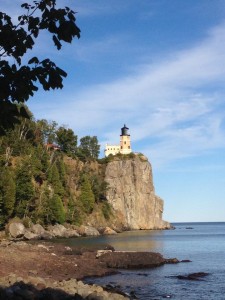
The Split Rock Lighthouse is perched high above Lake Superior. (Cheryl Welch | Travel Beat Magazine)
Minnesota lighthouses and doughnuts
So you’ve now made it to the west side of the Lake Superior.
Towns are becoming more sparse, and the sights are becoming more unspoiled. You will be driving along for miles staring out at the lake with nothing between you and the lake other than a little strip of beach.
Rising up from the lake, on a high cliff that can be viewed from the beach below, is the Split Rock Lighthouse. This beauty is worth a stop. The state park charges a fee, but it’s worth it for the views, the pictures, the history, and to avoid a sprained ankle by trying to keep it cheap and hiking toward it from the beach along uneven rocks. (Yes, this happened to me.)
After Split Rock Lighthouse, there are two towns to stop into—Lutsen and Grand Marais, Minnesota.
Lutsen is home to ski slopes and north shore retreats and has a historic lodge that’s right out of 20th century splendor of days gone by. The lodge has a first-rate restaurant, activities, and a Lake Superior beach complete with nightly bonfires under the starry sky.
Grand Marais is one of your last stops before you hit the Canadian border. It has the Lake Superior Trading Post, a unique spot to search for warm weather gear and interesting knick knacks (although take a look at the town’s Five and Dime store before going, as it offers less expensive goods). This town is also home to the World’s Best Donuts. Definitely stock up on these sweet pastries (get a variety pack) … the line out the door indicates their worth … and you’ll thank us a day or two later as you’re trying to find decent food in Canada to eat.
Mining for amethyst (for real)
You’ve now crossed the border into Canada and you’re heading north to northeast on Route 17. You’ll got by several amethyst mines on your way out of Thunder Bay.
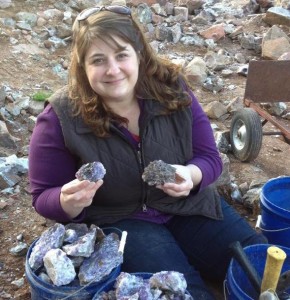
Searching for amethyst is easy and fun. It’s like being a kid in the sandbox again. Here’s Cheryl enjoying some rock hounding time at the Blue Point Amethyst Mine outside of Thunder Bay, Ontario. (Kevin Kaiser | Travel Beat Magazine)
Among them is Blue Point Amethyst Mine, in our opinion, the mine to go to in the Thunder Bay, Ontario, area. We didn’t know what to expect, but we took a chance on this diamond in the rough. And, boy, did that risk ever pay off. It is a real gem.
The owner and his assistants are so incredibly friendly and helpful, and the mining experience was authentic and fair in its pricing. We arrived later in the day, but the owner let us stay for as long as we liked as we dug around in the dirt and rocks, pounded away on rocks with hammers, and generally had a blast. (Especially after Dynamite Bob came to blow the mine.)
We found a lot of really great amethyst and they only charged $20 a bucket (and it could be an overflowing bucket). They even gave us boxes and newspaper to wrap our gems in for transportation. Seriously, this is the real deal.
There were no admission fees (the other mine just four miles closer to Thunder Bay charges an admission fee just to park and then a per-pound price for seconds, thirds and fourths quality stuff.) We got top quality amethyst stones at a third or less of the price.
Tips: It’s off the road a bit, but keep following the signs. When you get to the place, you’ll see a bus, a shack and a couple of camping trailers. You’re in the right place … don’t worry. There is a rustic outhouse and no real facilities to speak of, so if you’re into authentic experiences, this one’s for you. If you’re looking for luxury, this isn’t the one.
Seeing the Giant and sea otters

The serenity and wild beauty of Lake Superior creates a sense of calm and wonder in those venturing on the Lake Superior Circle Tour. (Cheryl Welch | Travel Beat Magazine)
Sleeping Giant Provincial Park is a behemoth of a park. Here you’ll drive on slabs of rock, see beautiful vistas of the lake, and hike in the wilderness without another human for miles.
If it’s solitude you seek, spend a day or two here. The hiking is rugged with miles of often unmarked trails. And every turn you take leads to another breathtaking view.
There are a few places to stay around here, and plenty of camping, but our pick was a little bed and breakfast owned by a German immigrant, Maria. She opens a couple of rooms of her home to visitors, and provides great companionship and breakfast tea to her new friends. Her backyard slopes down to the water’s edge of a still, beautiful inlet, and she’ll tell you all about the sea otters who like to frolic on her deck.
Also near Sleeping Giant is a silver mine and general store at peninsula’s tip. It wasn’t open when we stopped in September, but it looks to be a great place to pick up an ice cream and take a tour.
The ‘Thunder run’
Once you get out of Thunder Bay, there are miles of highway cross crossing the Canadian railroad and stretching along Lake Superior. Locals talk about having to make a “Thunder run” once a month to get supplies and groceries.
You’ll see a whole lot of abandoned motels of yesteryear, and great views of the lake.
Not a whole lot else.
That is, until you reach other parks, which are all nice and had great facilities. Among our favorites are the Aguasabon Falls & Gorge, from which you’ll take a short stroll from the parking lot to see the huge falls and gorge below, and Rainbow Falls Provincial Park.
Rainbow Falls is a short hike in from the parking lot. Hiking down a series of steps, you’ll see more and more of the falls as the water rushes over rock ledges on its journey to Lake Superior. This is a long falls, and you can walk down as far as you like, but note you’ll have to come back up the way you went down so we recommend leaving several hours of daylight for this visit.
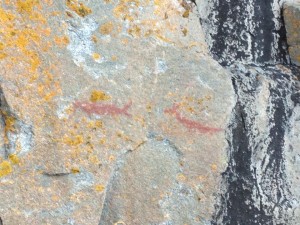
The Agawa Rock Pictographs were painted by tribesmen and women hundreds of years ago. The 35 artworks are on a rock face directly above Lake Superior. Getting to them can be a precarious proposition, but certainly well worth the effort. (Cheryl Welch | Travel Beat Magazine)
We then suggest trucking it from Rainbow Falls down to Lake Superior Provincial Park and the east side of Lake Superior south of Wawa, Ontario.
Near the park, you’ll find the Agawa Indian Crafts & The Canadian Carver trading outpost, which is stacked full of interesting crafts. This is a great place to stretch your legs and take in the view of Pancake and Batchawana bays. There’s lodging close by, and you can get a fresh start exploring Lake Superior Provincial Park.
The park is home to the Agawa Rocks Pictographs (viewable after a moderate hike down to the Lake Superior cliffs.) Note that if the rocks are wet or Lake Superior is cold (as in, it’s not mid-summer) or choppy, do not attempt to go out onto the rocks for a good look at these red ochre images. There are chains to hold onto, but the rocks get rather slippery.
The hikes are beautiful along here, and in good weather there is world-class paddling to be had as well. It’s a great last stop before heading back to Michigan and completing your circle tour.